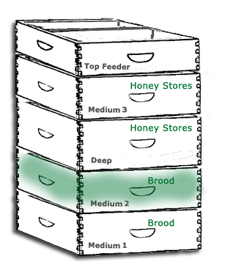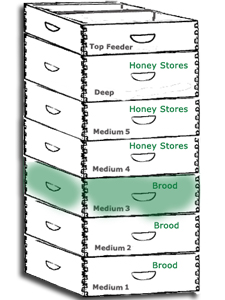 Beekeepers often refer to September 1st as the "Beekeeper New Year," a time to start putting the bees to bed for this year, and to make preparations for next. These tasks include checking to see whether the hives seem to have stored adequate honey for the winter – around here that means at least 60, and as much as 90 pounds – placing menthol to drive away tracheal mites, deciding upon and executing a treatment for varroa mites (those are the ones you might have heard about on the news), and pouring in sugar syrup that contains a medication for Nosema, a digestive tract disease that sort of gnaws away at the health and productivity of a colony.
Beekeepers often refer to September 1st as the "Beekeeper New Year," a time to start putting the bees to bed for this year, and to make preparations for next. These tasks include checking to see whether the hives seem to have stored adequate honey for the winter – around here that means at least 60, and as much as 90 pounds – placing menthol to drive away tracheal mites, deciding upon and executing a treatment for varroa mites (those are the ones you might have heard about on the news), and pouring in sugar syrup that contains a medication for Nosema, a digestive tract disease that sort of gnaws away at the health and productivity of a colony. The Nosema medication is an antibiotic, Fumidil-B. I am somewhat unhappy about this, not much wanting to get involved in chemicals and so on whether in the garden, the dog, or the husband. The disease that requires the med itself is an outgrowth of the stress that bees endure in the winter: they do not defecate at temps below 50 degrees, and the stress of holding waste can promote digestive disease. Fumidil targets a microbe (I think) that loves being in a crowded bee gut. It's a powder that you mix with a couple of gallons of 2 parts sugar to one part water (a heavy mixture). I planned on finishing each hive visit with a feeder fill-up with this stuff.
 The menthol all went in in mid-September, just before I found out that it was potentially OK to skip it. I chose ApiLifeVAR as my varroa treatment, mostly because it is not an antibiotic per se but a concentration of essential oils (thyme, eucalyptus, menthol). It's organic and non-polluting. The varroa treatment comes in wafers that must not touch bare skin, and which needed to be enclosed in little screen envelopes to keep the bees out of direct contact, too. So I had a bit of homework to do before placing it. And putting it in the hives would be a chore in itself: you can see from the green areas in the illustrations where the wafres need to go, directly above the brood nest. The first, and smaller, colony is Wilde, my girls who have struggled along this year. The second illustration is much-larger Twain, rampantly healthy and tending to rapacious behavior.
The menthol all went in in mid-September, just before I found out that it was potentially OK to skip it. I chose ApiLifeVAR as my varroa treatment, mostly because it is not an antibiotic per se but a concentration of essential oils (thyme, eucalyptus, menthol). It's organic and non-polluting. The varroa treatment comes in wafers that must not touch bare skin, and which needed to be enclosed in little screen envelopes to keep the bees out of direct contact, too. So I had a bit of homework to do before placing it. And putting it in the hives would be a chore in itself: you can see from the green areas in the illustrations where the wafres need to go, directly above the brood nest. The first, and smaller, colony is Wilde, my girls who have struggled along this year. The second illustration is much-larger Twain, rampantly healthy and tending to rapacious behavior.I went into Wilde first, thinking to start with the lesser weight and work, and move up to the bigger boxes on Twain. I was happily surprised to find an entire capped deep of honey on Wilde: this means I do not need to transfer resources from the other colony over! Hurrah! It also means I could have extracted honey for real this year, but what the hell.
The work in Wilde took less than 20 minutes, I think. The girls were quite pacific, and that technique (learned from MaryEllen) of throwing a cloth over each box as it was moved off the hive really seems to help. I burrowed down to the brood nest, placed the little screened packets, and reassembled. When I put the feeder back on top, bees crowded around my hands and the bucket, tongues stuck out, no mean buzzing. (There are different tones and behaviors of buzzing, and these girls were as mellow as all get out). My gloved hands (had to use the latter, when dealing with meds) were covered with happy bees licking off the drops of sugar syrup. Yum.
Twain was rowdier, probably because the smoke did not reach the inside boxes as well. Got stung once, but it might have been me mashing the bee against my leg as I worked. All told, they were WAY less upset at this hive manipulation than anything I have done in months. They seemed really hungry, too. though the boxes were full of honey. Twain took me more like forty minutes...those boxes are so heavy, and it is so easy to squash tons of bees as I grapple for a handhold and turn about. There were some truly mad mad mad bees at Twain, but they dropped pursuit long before I got back to the deck table where I put away my tools and wash my hands, etc.
Mostly they seem to be settling down for the season, and I plan on bringing them some more syrup when I come back in a week or so to replenish the ApiLife Var wafers. Now I need a shower, and I have a husbandly offer of lunch. I, too, can use a bit of autumn nourishment.
No comments:
Post a Comment